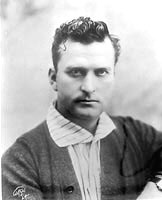Honestly, when I think of Thomas H. Ince, I think of Cary Elwes. I doubt I’m the only one. I, along with many others, first encountered the story of his death through The Cat’s Meow, a movie that frankly has inspired a half-dozen articles for this column (and we’re not done yet; come back in two weeks for the last one). Its version of events is the one told to Peter Bogdanovich by Charles Lederer, nephew of Marion Davies. It resembles that told by Toraichi Kono, valet to Charlie Chaplin. But pretty much everyone who was on the yacht that weekend, not to mention Ince’s widow Nell, insisted Ince died of natural causes.
What we know is this. Thomas Harper Ince was born in 1880, the son of a minor actor. He himself made his Broadway debut at age 15. He married Elinor “Nell” Kershaw, did some unsuccessful vaudeville, and continued acting. In 1910, he encountered former coworker William S. Hart and, through a series of events, ended up directing for D. W. Griffith. That, in turn, led to his start at producing. He built one of the most prominent studios of the silent era on land that would eventually become Universal Studios.
Ince produced a whopping 439 shorts and 170 features. It is true both that most of those have faded into obscurity and that credits were different in those days and those were likely just the things produced by his studio, but it’s still worth noting that his producing days lasted less than fifteen years. What’s more, he personally directed 139 shorts, writing fifty, and fifteen movies, writing seventeen. He acted in nine shorts, including what I believe is the first attempt at filming Richard III. It’s quite clear that Ince had become a driving force in the new Hollywood film industry; indeed, he was one of the first filmmakers to move there in the general Escape From Edison’s Lawyers exodus of the teens. He was also the first American to hire Sessue Hayakawa.
That is, in fact, what he was doing on the Oneida that weekend in the first place. Ostensibly, it was to celebrate his birthday; he was just 44 when he died, making the coveted list of People Younger Than I Am I’m Covering For This Column. (Which I admit is less coveted these days, with the extended age range, but I would’ve written about him anyway.) However, what he was actually doing was negotiating a deal whereby he’d produce pictures for William Randolph Hearst. It may have been social, but it was also a business deal.
Nell Ince insisted that she would not have stood aside had her husband been murdered. There is much talk of the comfortable circumstances she was in, allegedly because of a payoff from Hearst, but then she was already wealthy when her husband died. There is nothing suspicious about his cremation; he was a Theosophist, and fans of Ask a Mortician know that the Theosophists were adherents of cremation as a funerary rite. However, a lot would’ve been solved had there ever been an autopsy. It’s definitely true that lies were told about his death—Wikipedia lists two possible places of death, and IMDb merely says “Beverly Hills.” Ince had long suffered from health problems, having hidden them so he could keep working. An autopsy would’ve settled most, but probably not all, of the stories.

